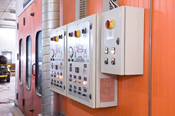
|
|
Distributed control system

A distributed control system (DCS) refers to a control system that is usually of a manufacturing system, process or any kind of dynamic system, in which the controller elements are not central in location (like a brain center) but are distributed throughout the system with each component sub-system being controlled by one or more controllers. The entire system of controllers is then connected by networks for communication and monitoring.
Distributed Control System is a very broad term that is used in a variety of industries, to monitor and control distributed equipment. Some of these are:
- Electrical power grids and electrical generation plants
- Environmental control systems
- Traffic signals
- Water management systems
- Oil refining plants
- Chemical plants
- Pharmaceutical manufacturing
- Sensor networks
- Dry cargo and bulk oil carrier ships
|
|
A Distributed Control Systemtypically will use custom designed processors as controllers and uses both proprietary interconnections and Communications protocol for communication.
Input and output modules form many of thecomponent parts of the Distributed Control System. The processor receives information from input modules and then sends information to output modules. The input modules receive information from input instruments that are in the process (a.k.a. field) and transmit instructions to the output instrumentsthat are in the field.
Computer buses or electrical buses then connect the processor and modules through multiplexer or de-multiplexers. Buses are also used to connect the distributed controllers with the central controller and finally to the Human-Machine Interface (HMI) or control consoles. This is known as the Process Automation system.
Elements of a distributed control system may be directly connected to physical equipment such as switches, pumps and valves or may work through an intermediate system such as a SCADA system.
Distributed Control Systems are dedicated systems that are used to control manufacturing processes that are continuous or batch-oriented, such as oil refining, petrochemicals, central station power generation, pharmaceuticals, food and beverage manufacturing, cement production, steelmaking, and papermaking. Distributed Control Systems are connected to sensors and actuators and use set point control to control the flow of material through the plant. The most common example is a set point control loop consisting of a pressure sensor, controller, and control valve. Pressure or flow measurements are transmitted first to the controller, usually through the aid of a signal conditioning Input/Output (I/O) device. When the measured variable has reached a certain point, the controller then instructs a valve or actuation device to open or close until the fluidic flow process reaches the desired set point.
The processes are not limited to fluid flow through pipes, however, and can also include things like paper machines and their associated variable speed drives and motor control centers, cement kilns, mining operations, ore processing facilities, and many others.
A typical Distributed Control System consists of functionally and/or geographically distributed digital controllers that are capable of executing from 1 to 256 or more regulatory control loops in one control box. The input/output devices (I/O) can be integral with the controller or they can be located remotely via a field network. Today's controllers have extensive computational capabilities and, in addition to proportional, integral, and derivativecontrol, can generally perform logic and sequential control because of their high level of design.
Distributed Control Systems may employ one or several workstations and can be configured at the workstation or by an off-line personal computer. Local communication is usually handled by a control network with transmission over twisted pair, coaxial, or fiber optic cable. A server and/or applications processor may be included in the system for extra computational, data collection, and reporting capabilities.
Privacy Policy, Terms of Use